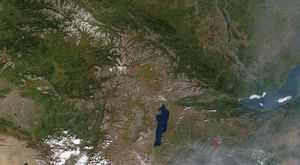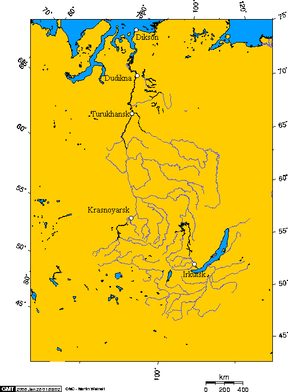Yenisei River
2007 Schools Wikipedia Selection. Related subjects: Geography of Asia
| Yenisei River | |
|---|---|
|
|
|
| Origin | Mongolia |
| Mouth | Arctic Ocean |
| Basin countries | Russia |
| Length | 5,550 km (3,449 mi) |
| Avg. discharge | 19,600 m³/s (692,272 ft³/s) |
| Basin area | 2,580,000 km² (996,138 mi²) |
The Yenisei (Енисе́й) is the greatest river system flowing to the Arctic Ocean, and the fifth longest river in the world. It is slightly shorter but with 1.5 times the flow of the Mississippi-Missouri. Rising in Mongolia, it follows a northerly course to the Kara Sea, draining a large part of central Siberia, the longest stream following the Yenisei-Angara-Selenga-Ider being about 5500 km. Its watershed, which includes the world's largest (by volume) lake, Lake Baikal, holds more water than any other river system.
The upper reaches, subject to rapids and flooding, pass through sparsely populated areas. The middle section is controlled by a series of massive hydroelectric dams fuelling significant Russian primary industry. Partly built by gulag labor in Soviet times, industrial contamination remains a serious problem in an area hard to police. Moving on through sparsely-populated taiga, the Yenisei swells with numerous tributaries and finally reaches the Kara Sea in desolate tundra where it is icebound for more than half the year. As with other Siberian rivers, the flow has increased recently, believed to be related to global warming. A concern is that altered salinity in the Arctic may have a global impact on ocean currents.
Upper Yenisei
The Yenisei rises in two major headstreams: the Bolshoi (greater) Yenisei also known as the Bii-Khem (Бии-Хем) rises in the Tuva region on the S flank of the Eastern Sayan Mountains and north of the Tannu-Ola Mountains at ; the Malyy (lesser) Yenisei also known as the Kaa-Khem (Каа-Хем) rises in the Darhat ( rift) valley in Mongolia. Recent research has shown that the narrow exit to the Darhat Valley has regularly been blocked by ice producing a lake as large as neighbouring Lake Khuvsgul. When the glaciers retreated (the last time 9300 years BP) as much as 500 km³ of water would have escaped, possibly catastrophically.
These two headstreams flow west converging at Kyzyl, and on meeting the east-flowing Khemchik River head north through a canyon in the Western Sayan mountains. The Yenisei emerges from the mountains onto an area of steppe where its first control is the 30m dam at Mayna. This section is around 700 km.
Lake Baikal Headwaters
The 320 km (partly navigable) Upper Angara feeds into the northern end of Lake Baikal from the Buryat Republic but the largest inflow is from the Selenga which forms a delta on the south-eastern side. The longest tributaries rise on the eastern slopes of central Mongolia's Khangay mountains. Another tributary, the Tuul passes through the Mongolian capital, Ulaanbaatar while the Egiin drains Lake Khuvsgul.

Just downstream from Mayna, the 242m Sayano-Shushenskaya dam at Sayansk powers Russia's largest hydroelectric plant completed in 1989 and producing 6400 MW for aluminium production. This is the same height and five times the power of the Hoover Dam. About 100 km downstream the Yenisei is swollen by the Abakan river and passes Abakan, capital of the Khakassia region, on the west bank and Minusinsk on the east bank. It passes within 10 km of the Chulym, a tributary of the Ob before reaching Krasnoyarsk after 300 km. This halt on the Trans-Siberian railway is the Yenisei's largest city. Krasnoyarsk is a major port. Not far away from Krasnoyarsk is Krasnoyarsk hydroelectric dam.
The closed city of Zheleznogorsk, 70km downstream, is a secret Soviet nuclear weapons and satellite facility missing from most maps. The exact state of the enormous nuclear waste dump is unclear, but some discharges continue to pollute the Yenisei. A further 200 km downstream comes the confluence with the Angara (whose final section is also known as the Upper [Verkhnyaya] Tunguska).
Angara River
The Angara (Ангара́) river drains Lake Baikal and runs 1840 km from the regional capital Irkutsk to converge with the Yenisei at Strelka (). It is dammed in four places to power local industry. The 44m dam at Irkutsk produces 650 MW. Bratsk lies 500 km downstream, where the 124 m dam built in the 1960s produces 4500 MW. The resultant reservoir is nicknamed Dragon Lake because of its outline. The tributary Oka and Iya rivers, which rise on the north slopes of the Eastern Sayan Mountains, form the 'jaws' and 400 km of the Angara form the 'tail'. There are newer dams almost as large at Ust-Ilimsk 250 km downstream (also damming the tributary Ilim river) and Boguchany a further 400 km downstream (not operational). Further dams are planned but the environmental consequences of completely taming the Angara are leading to protests which may prevent funding.
Angarsk, the centre of the expanding Eastern Siberian oil industry and site of a huge Yukos-owned refinery, lies 50 km downstream of Irkutsk. A major pipeline takes oil west, and a new one is being built to carry oil east for supply to Japan from the Sea of Japan port of Nakhodka. The exact potential of Eastern Siberia is unknown, but two new major fields are the Kovyktinskoye field near Zhigalovo 200 km north of Irkutsk and the extremely remote Verkhnechonskoye field 500 km north of Irkutsk on the Central Siberian Plateau.
Lower Yenisei
The Great Kaz joins the Yenisei 300 km downstream of the Strelka. It is noteworthy for its connection to the Ob via Ob-Yenisei canal and Ket River. The river starts to widen, its bed being littered with islands as numerous rivers augment its flow, in particular 1800 km Stony (Podkamennaya) Tunguska, and the 3000 km Lower (Nizhnyaya) Tunguska at Turukhansk draining the desolate central Siberian Plateau from the east. The remote Tunguska (Тунгуска) region is most famous for the 1908 meteorite impact, but is now being explored for oil. Beyond Turukhansk, the river enters tundra.
The river is icebound for more than half the year, and if unchecked ice could dam the river causing major flooding. Explosives are used to keep the water flowing. The final town is Dudinka which is connected to Krasnoyarsk by regular passenger boat. The river widens to a 50 km estuary for its final 250 km and the shipping lanes are kept open by icebreaker.
During the ice age, the route to the arctic was blocked by ice. Though the exact details are unclear, the Yenisei is believed to have flowed into a huge lake filling much of western Siberia, eventually flowing into the Black Sea. (See West Siberian Glacial Lake of the early Weichselian Glaciation)
Navigation
The first team to navigate the Yenisei's entire length, including its violent upper tributary in Mongolia, was an Australian-Canadian effort completed in September 2001. Ben Kozel, Tim Cope, Colin Angus and Remy Quinter were on this team. Both Kozel and Angus wrote books detailing this expedition, and a documentary was produced for National Geographic Television.
History
Ancient nomatic tribes such as the Ket people and the Yugh people lived along its banks. The Ket, numbering about 1000, are the only survivors today of those who originally lived throughout central southern Siberia near the river banks. Their extinct relatives included the Kotts, Assans, Arins, Baikots, and Pumpokols who lived further upriver to the south. The modern Ket lived in the eastern middle areas of the river before being assimilated politically into the Russia or Siberia during the 17th through 19th centuries.

